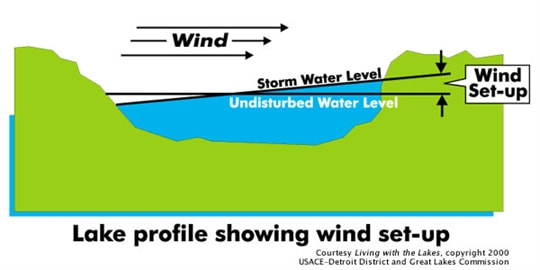Despite their vastness and ageless beauty, we often forget that the Great Lakes are a living system, an ever changing ecological process. Those fortunate enough to visit or reside along the shore of a Great Lake for any length of time are sure to recognize that the only constant associated with the shoreline is change. Water levels in the Great Lakes continuously rise and fall and have fluctuated throughout the history of the Great Lakes.
Check out these pages to learn more about:
– Local Government Planning and Coastal Resiliency – YouTube Webinar
– High Water in Northern Michigan
– Historic, Current, and Projected Water Levels
– Influences on Great Lakes Water Levels
– Frequently Asked Questions about Great Lakes Water Levels
– International Upper Great Lakes Study
Rising Waters in Northern Michigan – A webinar for shoreline property owners from May 14, 2020.
Water Level Fluctuations
The Great Lakes are a dynamic ecosystem that is constantly changing. Fluctuations in water levels are part of this natural system. Over the centuries, water levels have risen and fallen. The water levels also change with the seasons throughout the year. There is approximately 10-12 inches change between summer and winter. The water levels of the lakes can change a few inches daily depending on the amount of precipitation falling, rate of evaporation, and runoff from the land. Water levels can even change in a matter of minutes depending on which way the wind blows!
Short-term Changes
On any given day, the location of the water’s edge can change dramatically. Day-to-day fluctuations are caused by wind and wave action along the shore. Short-term fluctuations are known as wind set-ups, storm surges, or seiches. A wind set-up or storm surge is when strong, persistent winds blow across the surface of a lake in one direction and force an increase in water levels in the direction of the wind making the water levels drop at the other end. When the wind stops blowing or changes direction, water levels oscillate back and forth several times like a pendulum before returning to equilibrium. This is called a seiche. These short-term fluctuations are seen in the most extreme cases on the West-East running Lake Erie where water level differences have been recorded in excess of 9.9 feet. Short-term fluctuations typically last anywhere from a couple of hours to a couple of days.
Seasonal Changes
Great Lakes water levels fluctuate seasonally, reflecting the annual hydrologic cycle in the Great Lakes Basin. These annual or seasonal fluctuations are based mainly on changes in precipitation and runoff. Water levels begin to rise in the spring due to snowmelt, rain, and reduced evaporation. Water levels generally peak in June or July. By late summer, runoff decreases and water on the surface of the lake is warmer than the air above, resulting in greater evaporation. With less water entering the lake from runoff and more water leaving the lake through evaporation, water levels begin to fall. This results in a mid-winter low water level. Seasonal variations in water level of about a foot are typical for Lakes Superior, Michigan-Huron (which are hydrologically connected and, therefore, considered one lake), and Erie, while Lakes St. Clair and Ontario experience slightly higher seasonal variations.
Long-term Changes
The Great Lakes also experience long-term cycles corresponding to long-term trends determined by weather patterns, especially precipitation and temperature. In particular, Great Lakes water levels are especially influenced by winters: a hard winter, with above normal snowfall and bitter cold temperatures creating vast ice cover will cause lake levels to rise, whereas mild winters with higher temperatures and, subsequently, less ice cover and more evaporation will decrease lake levels.
For More Information
United States Army Corps of Engineers Great Lakes Water Levels
http://www.lre.usace.army.mil/Missions/GreatLakesInformation/GreatLakesWaterLevels.aspx
Environmental Research Laboratory Great Lakes Water Level Observations
http://www.glerl.noaa.gov/data/now/wlevels/levels.html
International Joint Commission International Upper Great Lakes Study
http://www.ijc.org/iuglsreport
| Title | Link |
|---|



